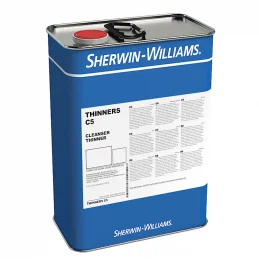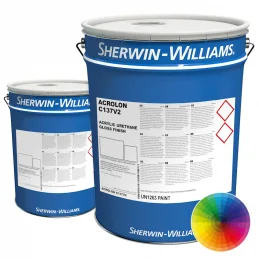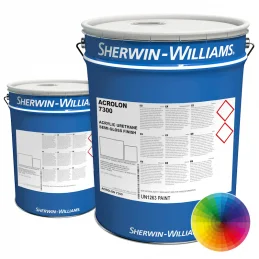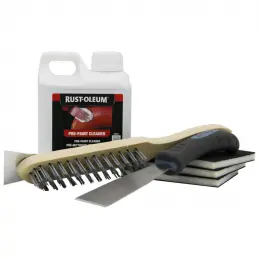- There are no more items in your cart
- Shipping Calculated at checkout
-
Sub-Total (inc. VAT)
£0.00
Sherwin-Williams Macropoxy C402V2 is a high build 2-pack epoxy zinc phosphate primer/buildcoat, which provides anti-corrosive protection of carbon steel surfaces prepared by abrasive blast cleaning.
- Network Rail endorsed
- Touch dry in up to 90 minutes at 23°C
- For use in internal/external exposed conditions, including offshore, petrochemical
- Can be applied at thicknesses between 75 and 250 microns
Sherwin-Williams Macropoxy C402V2 is a high build 2-pack epoxy zinc phosphate primer/buildcoat, which provides anti-corrosive protection of carbon steel surfaces prepared by abrasive blast cleaning.
May be brush applied onto hand or mechanically prepared surfaces and/or damp gingered surfaces, giving excellent wetting and adhesion characteristics.
Can be applied at thicknesses between 75 and 250 microns dry to provide both primer and buildcoat in a single coat. A top coat is only required for decorative purposes.
Without topcoat, the material will quickly discolour, and patchiness may be exaggerated due to film thickness variation but will nonetheless provide excellent anti-corrosive protection as a single coat protective epoxy nor will intercoat adhesion be affected by any discolouration. See reverse side for further information on colour stability.
For use in internal/external exposed conditions, including offshore, petrochemical, but not for fully immersed applications.
Quick Links - Click To Jump To Section:
- Features & Benefits
- Product Specification
- Drying Times
- Thickness Rates
- Application Rates
- Recommended Topcoats
- Surface Preparation
- Application
- Additional Notes
- Case Studies
- Health and Safety
Features & Benefits
- Network Rail endorsed
- Touch dry in up to 90 minutes at 23°C
- For use in internal/external exposed conditions, including offshore and petrochemical
- Can be applied at thicknesses between 75 and 250 microns
Product Specification
| Product Details | |
|---|---|
| Sherwin-Williams Macropoxy C402V2 | |
| Endorsements: | Network Rail Item No. 7.1.5 (Aluminium only), 7.1.7, 7.2.2 (other shades) |
| Flash Point: |
Base: 24°C Additive: 26°C |
| Volume Solids: | 75 ± 3% |
| Pot Life: |
2 hours at 5°C 1 hour at 23°C |
| VOC: | 217 gms/litre determined practically in accordance with UK Regulations PG6/23 249 gms/litre calculated from formulation to satisfy EC Solvent Emissions Directive 159 gms/kilo content by weight from formulation, to satisfy EC Solvent Emissions Directive |
| Mixing Ratio: | 4.71 parts base to 1-part additive by volume |
| Shelf Life: | 2 years from date of manufacture or ‘Use By’ date where specified |
Drying Times
| Drying Times | |||
|---|---|---|---|
| 15°C | 23°C | 35°C | |
| To Touch: | 2 hours | 1½ hours | 1 hour |
| To Recoat: | 6 hours | 4 hours | 3 hours |
| To Handle: | 16 hours | 8 hours | 3 hours |
- These figures are given as a guide only
- Factors such as air movement and humidity must also be considered
Thickness Rates
| Thickness Data | |||
|---|---|---|---|
| Dry film thickness | Wet film thickness | Theoretical coverage | |
| 100 microns | 133 microns | 7.5m²/ltr* | |
- * This figure makes no allowance for surface profile, uneven application, overspray or losses in containers and equipment
- Film thickness will vary depending on actual use and specification
Application Rates
| Application Data | ||||
|---|---|---|---|---|
| Airless Spray | Conventional Spray | Brush | Roller | |
| Dry | 100* | 100 | 75 | 65 |
| Wet | 133 | 133 | 100 | 87 |
- * Maximum sag tolerance with overlap typically 533μm wet (400μm dry) by airless spray and 187μm wet (140μm dry) by brush
Recommended Topcoats
- For overcoating with epoxy products (including self-overcoating), the maximum recommended interval is 28 days at 23°C. For overcoating outside this interval, consult Rawlins technical team on Tech - 0113 2455450 (option 2) or [email protected] for advice
- Where a high degree of gloss and colour retention is required, overcoat with Acrolon C137V2, Acrolon C237, Acrolon 1850 and Acrolon 7300 within 7 days at a minimum dft of 50 microns or in the case of Acrolon C750V2 overcoat within 4 days. These overcoating times refer to achievement of optimum adhesion at 23°C and will vary with temperature
- For overcoating outside the above parameters and with alkyd systems, consult Rawlins technical team on Tech - 0113 2455450 (option 2) or [email protected] for further advice
Surface Preparation
- Blast clean to Sa2½ (ISO 8501-1:2007). Average surface profi le in the range 50-75 microns
- Manually prepared surfaces should be prepared to a minimum standard of St3 ISO 8501-1:2007 at the time of coating
- Application to such surfaces should be by brush or roller where the mechanical action will aid adhesion
- Ensure surfaces to be coated are clean, dry, and free from all surface contamination
Application
- Epoxy paints should preferably be applied at temperatures in excess of 10°C. Relative humidity should not exceed 90% and in these conditions good ventilation is essential. Substrate temperature shall be at least 3ºC above the dew point and always above 0°C
- At application temperatures below 10°C, drying and curing times will be significantly extended, and spraying characteristics may be impaired. Application at ambient air temperatures below 5°C is not recommended. To achieve optimum water and chemical resistance, temperature needs to be maintained above 10°C during curing
- If it is desired to overcoat outside the times stated on the data sheet, please seek advice of Rawlins Technical Team on Tech - 0113 2455450 (option 2) or [email protected]
| Airless Spray | ||
|---|---|---|
| For dft applications between 75-125μ | For dft applications between 125-250μ | |
| Nozzle Size: | 0.33mm (13 thou) | 75 |
| Fan Angle: | 40° | 40° |
| Operating Pressure: | 155kg/cm² (2200 psi) | 155kg/cm² (2200 psi) |
- The airless spray details given above are intended as a guide only
- Details such as fluid hose length and diameter, paint temperature and job shape and size all have an effect on the spray tip and operating pressure chosen. However, the operating pressure should be the lowest possible consistent with satisfactory atomisation
- As conditions will vary from job to job, it is the applicators’ responsibility to ensure that the equipment in use has been set up to give the best results. If in doubt Rawlins Technical Team should be consulted on Tech - 0113 2455450 (option 2) or [email protected]
| Conventional Spray | |
|---|---|
| Nozzle Size: | 1.27mm (50 thou) |
| Atomising Pressure: | 2.8kg/cm² (40 psi) |
| Fluid Pressure: | 0.4kg/cm² (6 psi) |
- The details of atomising pressure, fluid pressure and nozzle size are given as a guide. It may be found that slight variations of pressure will provide optimum atomisation in some circumstances according to the set up in use. Atomising air pressure depends on the air cap in use and the fluid pressure depends on the length of line and direction of feed i.e. horizontal or vertical
- For application by conventional spray, it may be necessary to thin the paint by the addition of up to 10% Cleanser Thinner No. 5. Where thinning has been carried out the wet film thickness must be adjusted accordingly
- N.B. Thinning will affect VOC compliance. Brush and Roller: The material is suitable for brush and roller application. Application of more than one coat may be necessary to give equivalent dry film thickness to a single spray applied coat
Additional Notes
- Drying times, curing times and pot life should be considered as a guide only
- The curing reaction of epoxies commences immediately the two components are mixed, and since the reaction is dependent on temperature, the curing time and pot life will be approximately halved by a 10°C increase in temperature and doubled by a 10°C decrease in temperature
- It is possible to apply Macropoxy C402V2 onto a damp substrate (no running water or pooled water) by brush application. Ensure that the paint fully displaces any water on the surface
Epoxy Coatings - Colour Stability
- Variable colour stability is a feature of epoxy materials which tend to yellow and darken with age particularly when used on internal areas. Therefore, any areas touched-up and repaired with the same colour at a later date may be obvious due to this colour change
- When epoxy materials are exposed to ultra-violet light a surface chalking effect will develop. This phenomenon results in loss of gloss and a fine powder coating at the surface which may give rise to colour variation depending on the aspect of the steelwork. This effect in no way detracts from the performance of the system
Epoxy Coatings - Tropical Use
- Epoxy paints at the time of mixing should not exceed a temperature of 35°C. At this temperature, the pot life will be approximately halved. Use of these products outside of the pot life may result in inferior adhesion properties even if the materials appear fit for application. Thinning the mixed product will not alleviate this problem
- The maximum air and substrate temperature for application is 50°C providing conditions allow satisfactory application and fi lm formation. If the air and substrate temperatures exceed 50°C and epoxy coatings are applied under these conditions, paint film defects such as dry spray, bubbling and pinholing etc. can occur within the coating
- Numerical values quoted for physical data may vary slightly from batch to batch
Case Studies
Edinburgh Waverly Railway Station
| Case Study Specifications | |
|---|---|
| Substrate: | Cast and wrought iron with some new steel sections |
| Requirements: | To provide anti-corrosion protection for a minimum period of 25 years |
| Specifications: | Principally Network Rail Protective System M24/049. Calton Road Footbridge was repainted with Network Rail Protective System M34. All new steelwork was coated with Network Rail Protective System N13/008 |
| Area coated: | Approx. 50,000 m² |
| Client: | Network Rail |
Edinburgh Waverley railway station is the main station in the Scottish capital. Covering an area of more than 101,000 m² (25 acres) in the centre of the city, it is the second-largest main line railway station in the United Kingdom in terms of area, and is both a terminal station and a through station, in contrast to most of the major London stations.
The major challenge was to prepare and repaint all the iron work without inconveniencing passengers and disrupting the day to day running of this busy railway station. Not all areas could be abrasive blast-cleaned, so the contractor required a protective system that was suitable for blast-cleaned and mechanically prepared iron work.
| Case Study System | |
|---|---|
| Steelwork: | Most of the existing steelwork was repainted with Network Rail Protective System M24/049, which comprised of |
| Requirements: | To provide anti-corrosion protection for a minimum period of 25 years |
| Specifications: | Principally Network Rail Protective System M24/049. Calton Road Footbridge was repainted with Network Rail Protective System M34. All new steelwork was coated with Network Rail Protective System N13/008 Macropoxy™ C402V2 (aluminium), stripe coat of Macropoxy™ C402V2, Macropoxy™ C402V2 (off white), Acrolon™ C137V2 (various colours). |
| Footbridges: | One of the footbridges (Calton Road) was coated using Network Rail Protective System M34/002, which comprised of Macropoxy™ M922M, stripe coat of Macropoxy™ M922M, Acrolon™ C137V2 |
| New/Replacement Steel: | New or replacement steel was coated with Network Rail Protective System N13/008, which comprised of Macropoxy™ L674, stripe coat of Macropoxy™ C402V2, Macropoxy™ C402V2, Acrolon™ C137V2. Most of the steelwork was blast-cleaned to Sa2½ surface standard. Some areas were mechanically prepared to St3 surface standard. |
Health and Safety
- Please read the product data sheet and safety data sheets for this product in the attachments section above
Data sheet
- Manufacturer
- Sherwin-Williams
- For Use By
- Industrial Use
- Water / Solvent Based
- Solvent
- For Use On
- Carbon Steel
- Application Method
- Airless Spray, Spray, Brush, Roller
- Sheen
- Matt
- Colour
- Standard / Ready Mixed
- Single, Two or Three Pack
- Two-Pack
- Product Certifications
- Network Rail Item No. 7.1.5, 7.1.7, 7.2.2
- Pack Size
- 5L, 20L
- Coverage
- 7.5m² per litre
- Touch Dry
- 1.5 Hours
- UN Number (Activator)
- UN3470
- UN Number (Base)
- UN1263
- Base Type
- Epoxy
- Base Type
- Solvent Based
- Suitable For Use On
- Steel
- Suitable For Use On
- Carbon Steel
- Finish
- Matt
- Application Method
- Brush
- Application Method
- Roller
- Application Method
- Spray
- Usages
- High Build
- Usages
- Moisture Tolerant
- Usages
- Atmospheric
- Usages
- Anti-Corrosive
- Usages
- Zinc Phosphate
- Product Usage Type
- Primer
- Product Range
- Macropoxy
- Colour Family
- Grey
- Colour Family
- Off-White
- Colour Family
- Aluminium
- Dry to Recoat (@ 20-25°C)
- 4 hours
Questions
Question about the product
Be the first to ask a question about this product!
IMPORTANT SHIPPING & DELIVERY INFORMATION
Sherwin-Williams Macropoxy C402V2 is only available with the shipping and delivery timescales listed below - please do not contact our Customer Support Team with enquiries about alternative or earlier shipping and delivery times.
Saturdays and Sundays, as well as Bank Holidays, are not classed as working days.
Orders placed after the cut-off for this product will not be processed for earliest dispatch until 9am the next working day.
All delivery costs below are excluding VAT

Sherwin-Williams Acrolon 1850
Sherwin-Williams Acrolon 1850 is a two pack Isocyanate free finish based on an acrylic epoxy binder system. It is a finish coat for exterior exposed surfaces where retention of gloss is required, and the use of isocyanate products is precluded or undesirable. Available in 400+ colours, including RAL and BS Order a Colour Sample

Sherwin-Williams Cleanser/Thinner No.5
Sherwin-Williams Cleanser/Thinner No.5 is a specially formulated blend of solvents designed to mix with its compatible Sherwin-Williams products to create an optimal consistency for application whether it be for Brush, Roller or Spray. It can also be used for cleaning of surfaces and application equipment. Specially formulated blend of...

Sherwin-Williams Acrolon C137V2
A high performance, fast drying acrylic urethane gloss finish in 450+ colours for use where long term exterior gloss and colour retention characteristics are required. Suitable for use as a final coat(s) in conjunction with epoxy or polyurethane based protective systems for new construction or maintenance purposes Please note: Also...

Sherwin-Williams Acrolon C237
Sherwin-Williams Acrolon C237 (formerly Resistex C237) is a high performance fast drying acrylic urethane sheen finish for use where long term exterior colour retention characteristics are required. It is suitable for use as final coat or coats in conjunction with epoxy or polyurethane based protective systems for new construction or...

Sherwin-Williams Acrolon C750V2
We no longer stock this product; please contact our technical team on 0113 2455450 (option 2) or send a message to [email protected] where we will be happy to find an alternative product.

Sherwin-Williams Macropoxy L674
We no longer stock this product, but can recommend Sherwin-Williams Macropoxy L574 as a great alternative. Please note: it is important to check that any alternative product is suitable for your requirements, as our suggestion is given in good faith but without warranty. If you are in any doubt please first contact our technical team on 0113...

Sherwin-Williams Acrolon 7300
Sherwin-Williams Acrolon 7300 is a high solids, tin free polyurethane, with fast drying and high gloss attributes. Acrolon 7300 can suitable for use where long term exterior gloss and colour retention characteristics are required. Gloss levels: Gloss: 70%+ Semi-Gloss - approx. 40% Available in 450+ colours Professional use only -...

Surface Preparation Kits for Steel
These surface preparation kits for steel have been created to help provide customers with an easily accessible bundle of tools to aid in the preparation of steel surfaces in accordance with ISO 8501-1 (St2/3) and SSPC (SP 2/3). Please click here for important information about these kits. Kit Contents: SET 1 (Hand Tools) 1 x Rust-Oleum...





